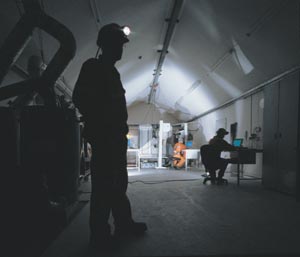
On 28 April, the UK minister for science and innovation, Lord Sainsbury, opened a new research cavern at the Boulby Underground Laboratory for Dark Matter Research, at Boulby in North Yorkshire, UK. The Boulby lab is situated in a working salt and potash mine and houses experiments to detect weakly interacting massive particles (WIMPs), a prime candidate for dark matter in the universe. The laboratory has recently benefited from a £3.1 million Joint Infrastructure Award (JIF) from the UK Particle Physics and Astronomy Research Council, which has provided new enhanced underground laboratories and complementary surface facilities.

Situated more than 1 km beneath the Earth’s surface within a salt and potash mine, the laboratory is isolated from interference from cosmic rays and benefits from an environment with low natural radioactivity. The laboratory operates on behalf of the UK Dark Matter Consortium – the University of Sheffield, the Rutherford Appleton Laboratory, the Imperial College of Science, Technology and Medicine, and the University of Edinburgh.
The Boulby lab currently houses three experiments to detect dark matter – NAIAD (NaI Advanced Array Detector), ZEPLIN I (from ZonEd Proportional scintillation in LIquid Noble gases, now operating with liquid xenon), and DRIFT (Directional Recoil Identification From Tracks). DRIFT is the first experiment to be installed in the new area of the laboratory and is unique because its aim is not only to detect WIMPS, but also to determine which direction they come from.





